The weapon of victory. "Degtyaryov Infantry" - machine gun DP 85 years
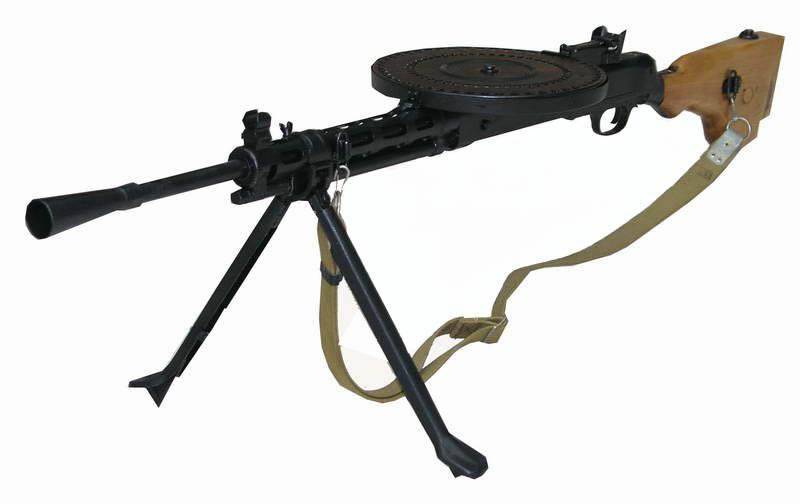
Vasily Alekseevich Degtyarev (1880-1949), the head of the PKB workshop at the Kovrov Plant, began developing his own model of a light machine gun at the end of 1923 of the year. As a basis, Degtyarev took the scheme of his own automatic carbine, which he proposed back in 1915 year. Then the inventor, combining the well-known schemes of vapor-controlled automatics (a side vent hole located below the barrel), locking the barrel bore using two lugs thrown by the drummer and his own solutions, received a compact system, which earned an approving official review of Fedorov. 22 July 1924 g. Degtyarev was presented the first prototype of a machine gun having a disk shop. The commission was headed by N.V. Kuibyshev, head of the school "Vystrel", Chairman of the Shooting Committee of the Workers 'and Peasants' Red Army. The commission noted the “outstanding originality of the idea, the rate of fire, the trouble-free operation and the considerable simplicity in handling Comrade Degtyarev’s system”. It should be noted that at the same time, the commission recommended for the adoption of the air forces of the Workers 'and Peasants' Red Army a paired aviation 6,5-mm machine gun Fedorov-Degtyarev. Degtyarev machine gun prototype and Kolesnikov and Tokarev machine guns, 6 in October 1924 were tested at the shooting range in Kuskovo, but dropped out of the competition because the firing pin was out of order. The commission for the selection of a model machine gun (Chairman SM Budyonny) was soon recommended for the adoption of the Red Army machine gun Maxim-Tokarev. He was accepted under the designation MT in 1925 year.
DP light machine gun
The next prototype, Degtyarev, was introduced in the fall of 1926. 27-29 September of two copies was made about five thousand shots, while it was found out that the ejector and the drummer have a weak force, and the weapon itself is sensitive to dusting. In December, the following two machine guns were tested in unfavorable shooting conditions; they gave 40000 shots of all 0,6% delays, but they were also returned for revision. At the same time, an improved model of Tokarev was tested, as well as Dreyse's German “light machine gun”. Sample Degtyarev, according to test results, surpassed the remake system of Tokarev and the machine gun Dreyze, which then caused great interest among the leadership of the Workers 'and Peasants' Red Army and, by the way, had the option with a large-capacity disk shop. Despite this, Degtyarev had to make a number of changes in his design: due to the change in the shape and use of chromium-nickel steel, the bolt carrier was strengthened, the piston rod and ejector were made of the same steel, and in order to strengthen the striker, he was shaped like a Lewis machine gun. It should be noted that some constructive solutions in Degtyarev machine guns were made under the clear influence of the thoroughly studied Madsen, Lewis and Gochkis light machine guns (the Kovrov plant possessed complete sets of drawings, as well as ready-made samples of Madsen, during the Civil War machine guns “Lewis” were repaired here). However, in general, the weapon had a new and original design. Two copies of the Degtyarev machine gun after revision were tested by the commission of the Artkom Artillery Directorate of the Red Army at the Kovrov plant 17-21 in January 1927 of the year. Machine guns were recognized as "tested". February 20 also recognized the Commission as “possible to present machine guns as samples for carrying out all subsequent work and considerations for installing them into production.” Without waiting for the results of improvements, it was decided to issue an order for a hundred machine guns. On March 26, the Artkom approved the Temporary Specifications for acceptance of the Degtyarev light machine gun developed by PKB of the Kovrov plant.
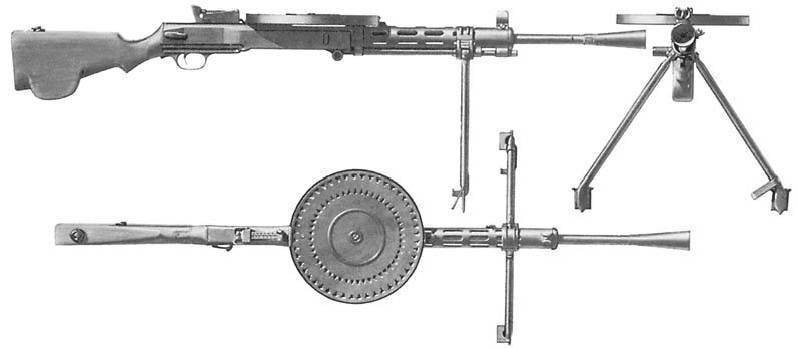
The first batch of 10 machine guns was submitted to the military 12 acceptance on November 1927 of the year, the military inspector fully accepted the 100 of January 3 of the year on the 1928 machine guns. January 11 The Revolutionary Military Council ordered the transfer of machine guns to 60 for military tests. In addition, machine guns were sent to military schools of various military districts, so that at the same time with the tests the commanding staff could get acquainted with the new weapons at camp gatherings. Troop and field testing continued throughout the year. According to the results of tests carried out in February at the Scientific Test Arms and Machine Gun Range and the “Shot” courses, it was recommended to add to the design a flame arrester designed to reduce the unmasking and blinding effect of the muzzle flame at dusk and at night. In addition, a number of other comments were made. In August, 1928 tested an improved sample with a flame arrester and a slightly modified gas chamber regulator nozzle. On 27-28, the company issued an order for 2,5 thousand machine guns. At the same time, at a special 15 meeting on June 1928 of the year, which was attended by the leaders of the Main Military-Industrial Directorate and the People's Commissariat of Defense, recognizing the difficulties of large-scale production of a new machine gun, set the 29-30 years as the deadline for its establishment with fully interchangeable parts. At the end of 28, it was decided to stop the production of MT machine guns (Maxim-Tokarev). As a result, Degtyarev's light machine gun came to the Red Army before its official adoption. The machine gun was adopted under the designation "7,62-mm light machine gun arr. 1927 g. "Or DP (" Degtyarev, infantry "), also met the designation DP-27. The machine gun of Degtyarev became the first mass machine gun of domestic development and brought its author among the main and most authoritative gunsmiths of the country.
The main parts of the machine gun: replaceable barrel with a flame arrester and a gas chamber; receiver with sighting device; cylindrical barrel housing with front sight and guide tube; shutter with a drummer; bolt carrier and piston rod; reciprocating combat spring; trigger frame with butt and trigger; disk shop; folding removable bipod.
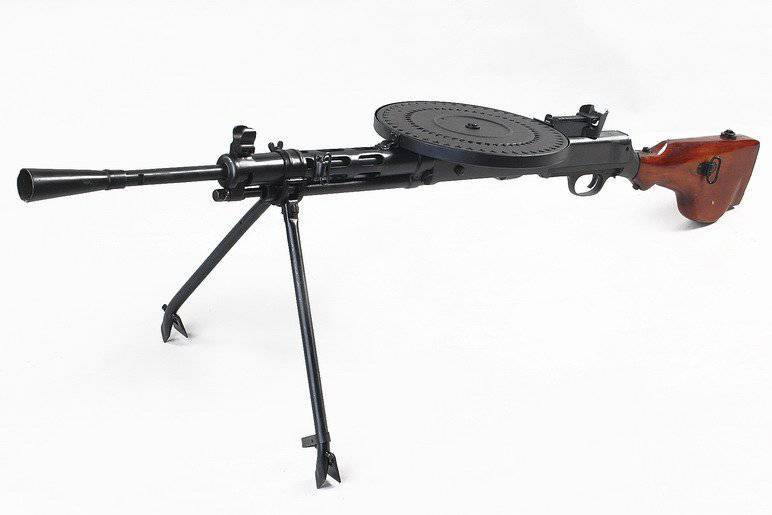
The barrel in the receiver was fastened with intermittent screw lugs, for fixing the flag contactor was used. In the middle of the trunk, there were 26 transverse ribs designed to improve cooling. However, in practice it turned out that the efficiency of this radiator was very low and, starting from 1938, finning was eliminated, which simplified production. A conical flame arrester was attached to the muzzle of the trunk using a threaded connection. During the march, a flame arrester to reduce the length of the DP was fixed in an inverted position.
And the automatic machine gun was implemented scheme of work due to the removal of powder gases through the side opening. The hole was made in the wall of the barrel at a distance of 185 millimeters from the muzzle. The gas piston had a long stroke. Gas chamber - open type, with a pipe. The piston rod is rigidly connected with the slide frame and the reciprocating spring, worn on the rod, was placed under the barrel in the guide tube. The gas piston was screwed on the front end of the rod, while fixing the return-combat spring. With the help of a nozzle regulator having two gas outlets with a diameter of 3 and a millimeter 4, the amount of exhaust powder gases was adjusted. The barrel bore was locked using a pair of lugs, reinforced on the sides of the bolt on the hinges and bred by the extended rear part of the drummer.
The trigger mechanism consisted of a trigger, trigger lever with a sear, an automatic fuse. Fuse backing the trigger back. To turn it off, it is necessary to completely cover the neck of the butt with a palm. USM was designed only for continuous fire.
Store, mounted on top of the receiver, consisted of a pair of disks and springs. Cartridges in the store were placed with the tip of a bullet to the center. The force of the cochlear spiral spring, which was twisted when the magazine was equipped, rotated the upper disk relative to the lower one, while cartridges were fed to the receiver window. The shop of this design was developed earlier for the air gun Fedorov. Initially, the requirements for a manual machine gun assumed that the power supply system would have 50 cartridges, but the disk “Fedorov’s magazine” designed for fifty 6,5-mm cartridges was ready for production, it was decided to keep its basic dimensions, reducing the drum capacity to 49 7,62-mm cartridges. . It is necessary to answer that the design of the magazine with the radial placement of cartridges could solve the problem of the reliability of the power supply system when using a domestic rifle cartridge with a protruding lip. However, soon the capacity of the store was reduced to 47 cartridges because the spring force was not enough to feed the last cartridges. Radial punching discs and annular stiffeners were designed to reduce their death during shocks and bumps, as well as reduce the likelihood of "jamming" of the store. A spring-loaded store latch was mounted in the sight block. On the march, the receiver window of the receiver was covered with a special shield, which was moved forward before installing the store. For equipment store used a special device PSM. It should be noted that the shop having millimeters 265 diameter created some inconveniences when carrying a machine gun during a battle. After a part of the ammunition was consumed, the remaining cartridges during movement created a noticeable noise. In addition, the weakening of the spring led to the fact that the last cartridges remained in the store - because of this, the calculations preferred not to fully equip the store.
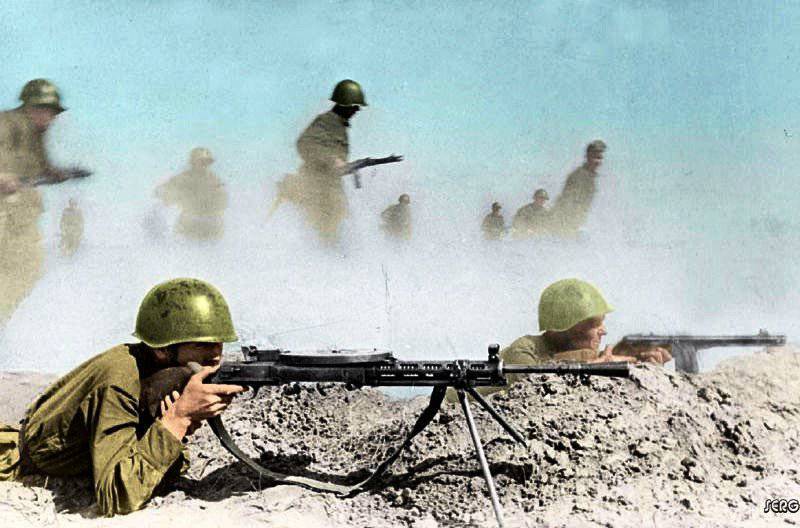
As in many machine guns, designed for significant heating of the barrel and intensive firing bursts, the shot was made from the rear sear. The bolt carrier with the bolt before the first shot was in the rear position, being held by the sear, while the return-combat spring was compressed (the compressive force was 11 kgf). The trigger lever was lowered when the trigger was pressed, the bolt carrier fell off the sear and moved forward, pushing the bolt and drummer with its vertical stand. The gate captured from the receiver cartridge, sent it to the chamber, resting on the stump of the barrel. During the further movement of the bolt carrier, the striker pushed the lugs apart with their broad part, the lugs of the abutments entered the lugs of the receiver. This locking scheme was very similar to the Swedish Chelman automatic rifle, which was tested in 1910 in Russia (although the rifle combined locking according to the “Friberg-Chelman scheme” and automatic recoil-based barrels with a short course). The drummer and bolt carrier, after locking, continued to move forward another 8 millimeters, the striker striker reached the cartridge cap, smashing it, a shot occurred. After the bullet passed through the gas vent holes, powder gases got into the gas chamber, hit the piston, which covered the chamber with its socket, and threw back the slide frame. After the drummer had a frame of approximately 8 millimeters, he released the lugs, after which the stops were reduced by bevels of the shaped frame, the barrel bore was unlocked on the 12 millimeter path, the bolt was picked up by the slide frame and retracted. In this case, the ejector removed the cartridge case, which, hitting the drummer, was ejected through the window of the receiver in the lower part. The bolt stroke was equal to 149 millimeters (shutter - 136 millimeters). After that, the bolt struck against the trigger frame and went forward under the action of the return-combat spring. If at this moment the trigger was pressed, the automation cycle was repeated. In the event that the hook was released, the bolt carrier stood up on the sear with its combat platoon stopping in the rear position. In this case, the machine gun was ready for the next shot - the presence of only one automatic shutter guard created the danger of an involuntary shot while moving with a loaded machine gun. In this regard, in the manuals it was stated that the loading of the machine gun should be made only after taking a position.
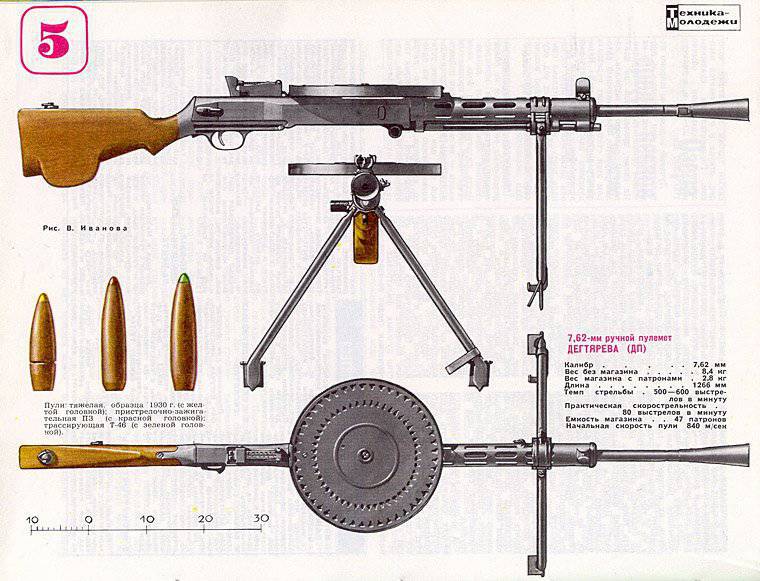
The machine gun was equipped with a sector sight with a high block, which was mounted on the receiver, and a bar with notches up to 1500 meters (100 meter pitch), and a front sight with protective ears. The fly was inserted into the groove on the protrusion of the barrel cover, which resembled the cover of the Madsen light machine gun. Protective "ears" for sight also served as a shop latch. The wooden butt was made according to the type of machine gun “Madsen”; it had a semi-pistol projection of the neck and an upper crest that improved the setting of the machine gunner’s head. The length of the butt from the trigger to the head was equal to 360 millimeters, the width of the butt was equal to 42 millimeters. In the butt was placed oiler. In the wider lower part of the butt of the DP-27 machine gun there was a vertical channel intended for the rear extendable support, but serial machine guns were made without such a support, and later on the channel in the butt was stopped. On the casing of the barrel and to the left on the butt were attached antabka for a belt. Bipods were fastened with a folding clamp having a screw-wing on the trunk casing, their legs were equipped with openers.
When firing, the machine gun showed good accuracy: the core of dispersion during firing by “normal” bursts (from 4 to 6 shots) at 100 meters was up to 170 mm (in height and width), at 200 meters - 350 mm, at 500 meters - 850 mm, on 800 meters - 1600 mm (in height) and 1250 mm (in width), on 1 thousand m - 2100 mm (in height) and 1850 mm (in width). During firing in short bursts (up to 3 shots), the accuracy increased - for example, at a distance of 500 meters the core of dispersion was already equal to 650 mm, and at 1 thousands of meters - 1650x1400 mm.
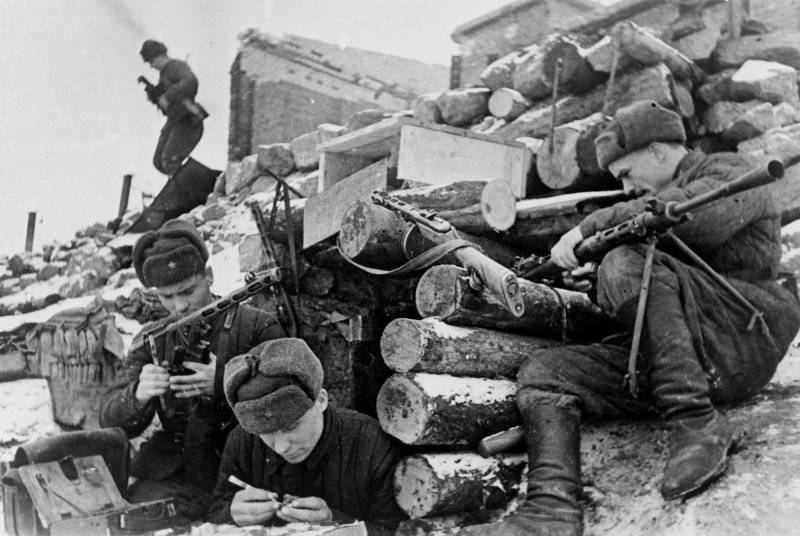
The DP machine gun consisted of 68 parts (without a magazine), of which 4 coil springs and 10 screws (for comparison, the number of details of the German Draize machine gun was equal to 96, American Browning BAR sample 1922 of the year - 125, Czech ZB-26 - 143 ). The use of the bolt carrier as the bottom cover of the receiver, as well as the application of the principle of multifunctionality when using other parts made it possible to significantly reduce the weight and dimensions of the structure. The advantages of this machine gun also included the simplicity of its disassembly. The machine gun could be disassembled into large parts, and with the removal of the bolt carrier, the main parts were separated. The Degtyarev machine gun included a collapsible ramrod, a brush, two drifts, a key screwdriver, a device for clearing gas paths, a wipe, and an extractor for detached dules of sleeves (the situation with the rupture of the sleeves in the chamber of the Degtyarev machine gun was observed long enough). Spare barrels - two for a machine gun - were supplied in specials. boxes. For carrying and storing the machine gun a canvas cover was used. To fire blank cartridges, a muzzle sleeve with a millimeter 4 outlet diameter and a special magazine with a box for blank cartridges were used.
The production of machine guns of the DP series was supplied and conducted by the Kovrov plant (State Allied Plant named after KO Kirkizha, Plant No. XXUMX of the People's Commissariat of Armaments, from 2 onwards - the Plant named after VA Degtyarev). Degtyarev infantry differed in ease of manufacture - for its production required two times less than the curve measurements and transitions than for a revolver, and three times less than for a rifle. The number of technological operations was four times less than for the Maxim machine gun and three times less than for MT. Many years of experience Degtyarev as a gunsmith-practitioner and cooperation with the outstanding gunsmith VG Fedorov. In the process of production production, changes were made to the heat treatment of the most critical parts, to introduce new processing normals, to select steel grades. It can be assumed that one of the main roles in ensuring the required accuracy during the large-scale production of automatic weapons with full interchangeability of parts was played by cooperation in the 1949-s with German specialists, machine-tool and weapon companies. A lot of labor and energy in the production of the machine gun of Degtyarev and in the standardization of the production of weapons on this basis invested Fedorov - during these works they introduced the so-called “Fedorov normals”, that is, the landing and tolerance system, designed to improve the accuracy of weapon production. A great contribution to the organization of the production of this machine gun was made by the engineer GA. Aparin, who supplied the factory tool and curved production.
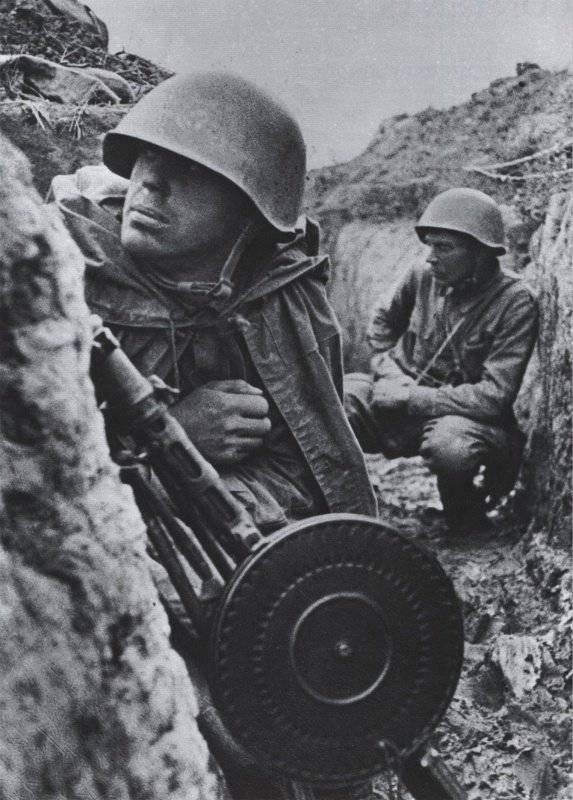
The DP order for 1928 and 1929 years was already 6,5 thousand units (of which 500 tank, 2000 aviation and 4000 infantry). After testing in March-April 30 by the special commission 13 of Degtyarev serial machine guns for survivability Fedorov stated that “the survivability of the machine gun was raised to 75 - 100 thousand shots”, and “the survivability of the least resistant parts (jets and ejectors) to 25 - 30 thousand shots shots.
In 1920-s, various light-weight, self-propelled machine guns were created in different countries - French “Hotchks” arr. 1922 of the year and Мle 1924 “Chatellerault”, Czech ZB-26, English “Vickers-Berthier”, Swiss “Solothurn” М29 and “Furrer” М25, Italian “Breda”, Finnish М1926 “Lahti-Zalorant”, Japanese “Ty” . The machine gun of Degtyarev favorably differed from the majority of them with comparatively high reliability and greater capacity of the store. Note that at the same time with the DP, another important means of infantry support was adopted - the 11-mm regimental cannon of the 76 model of the year.
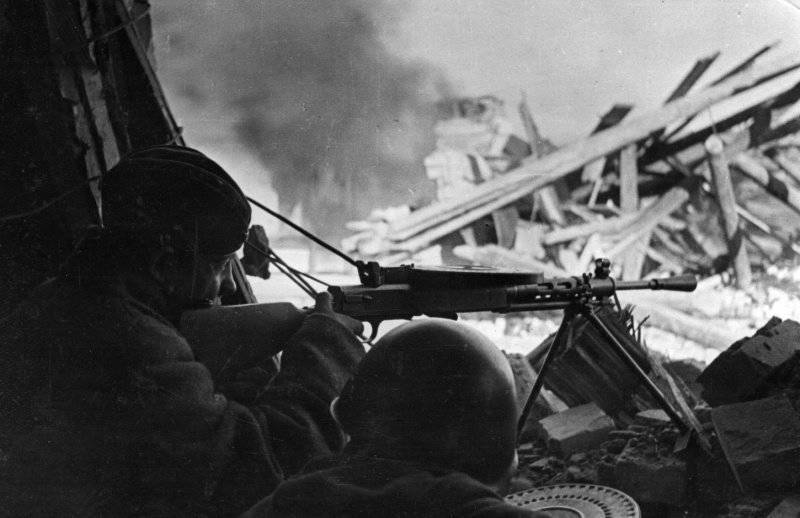
Technical characteristics of the machine gun DP:
Cartridge - 7,62-mm sample 1908 / 30 g. (7,62x53);
Machine gun weight (without cartridges): without bipods - 7,77 kg, with bipods - 8,5 kg;
Barrel weight - 2,0 kg;
Weight of bipods - 0,73 kg;
Machine gun length: without flame arrester - mm 1147, with flame arrester - mm 1272;
Barrel length - 605 mm;
The length of the threaded part of the trunk - 527 mm;
The grooves - 4 rectangular, right;
The length of the stroke rifling - 240 mm;
Initial bullet speed - 840 m / s (for light bullet);
Sighting range - 1500 m;
The direct shot range on the chest figure is 375 m;
The range of slaughter bullet - 3000 m;
Sighting line length - 616,6 mm;
The rate of fire - 600 shots per minute;
Combat rate - 100-150 shots per minute;
Food - disk magazine with 47 capacity;
Magazine weight - 1,59 kg (without cartridges) / 2,85 kg (with cartridges);
The height of the line of fire - mm 345-354;
Calculation - 2 person.
YES, DT and others
Since by the time of the introduction of the DP into service in the Soviet Union, the need to unify machine guns was recognized, other types of equipment, primarily aircraft and tank, were developed on the basis of the Degtyarev machine gun. Here again, the experience of developing a unified weapon of Fedorov was useful.
Another 17 of May 1926, the Artcom approved those. assignment for the design of a unified rapid-fire machine gun, which would be used as a manual in cavalry and infantry, and synchronous and turret in aviation. But it turned out to be more realistic to create an aviation machine gun based on an infantry. The practice of “turning” a light machine gun into a mobile aviation (on pivot, single turret, twin turret) was used as early as the First World War. In the period from December 27 to February 28, the aircraft version of the Degtyarev machine gun (“Degtyarev, aviation”, YES) was tested. The Scientific and Technical Committee of the Directorate of the Air Force of the Workers 'and Peasants' Red Army found it “possible to approve the submitted sample” of the Degtyarev machine gun for consideration in terms of a serial order. In the 1928 year, simultaneously with the fixed machine gun PV-1 designed by A.V. Nadashkevich created on the basis of the Maxim machine-gun, the airborne machine gun DA, which has a three-row (three-tier) magazine on 65 ammunition, a pistol grip, new sights with a vane-gun, was adopted for the air force.
To the front of the receiver aircraft machine gun Degtyarev screwed faceplate. In its lower part was attached king pin having a curved swivel for mounting on the installation. Instead, the butt was installed notched wooden pistol grip and rear handle. A sleeve with an annular sight was attached to the front from the top, and in the muzzle of the barrel a sleeve with a stand for a vane-fly was attached to the thread. Since the casing was removed and the faceplate was installed, there were changes to the mounting of the gas piston guide tube. From above the shop was equipped with a belt handle for quick and easy change. To ensure firing in a limited volume, as well as to prevent gun housings from getting into the mechanisms of the aircraft, a canvas bag-case with a wire frame and a bottom fastener was installed on the bottom of the receiver. Note that to search for the best configuration of the frame, which will ensure reliable removal of the sleeves without jamming them, in the domestic practice almost the first time was used for the slow motion shooting of the work. The weight of the machine gun YES was 7,1 kg (without magazine), the length from the edge of the rear handle to the muzzle - 940 millimeters, the mass of the magazine - 1,73 kg (without cartridges). As of 30 March 1930, the units of the Red Army air forces had 1,2 thousand machine guns YES and a thousand machine guns were prepared for delivery.
In 1930, the twin-turret DA-2 turret was also commissioned - the Scientific and Technical Committee of the Air Force Directorate ordered the Weapon and Machine-Gun Trust in 1927 to develop it on the basis of the Degtyarev aviation machine gun. The faceplate, located in front of the receiver, on each machine gun was replaced by a front attachment coupling. For mounting on the installation served side tides of couplings, to hold the gas piston tube - lower ones. Rear mounting machine guns on the installation were coupling bolts that went through the holes made in the rear tides of the receiver. N.V. Rukavishnikov and I.I. Bezrukov. The hook of the general descent was mounted on the pistol grip of the right machine gun in an additional trigger guard. The trigger pull was attached to the holes of the trigger brackets. Traction consisted of an adjusting rod and a connecting roller. On the left machine gun, the fuse box and bolt handle were transferred not to the left side, a bracket for the fly vane was mounted on its trunk. Since the recoil of twin machine guns was very sensitive to the installation and the shooter, the muzzle brakes of the active type were installed on the machine guns. Muzzle brake had the form of a kind of parachutes. Behind the muzzle brake was placed a special disc protecting the needle from the muzzle wave - later the brake of such a circuit was installed on a large-caliber DShK. Machine guns with a turret were connected through a pin. The installation was supplied with chin and shoulder rest (up to 1932, the machine gun had a chest support). Weight YES-2 with equipped magazines and a fly vane was 25 kilogram, length - 1140 millimeters, width - 300 millimeters, distance between axes of channels of trunks - 193 ± 1 millimeters. It is curious that YES and YES-2 adopted by the Office of the Air Force without formalizing the order of the People's Commissariat of Defense. These machine guns were put on the Tur-5 and Tour-6 turrets, as well as in the aircraft retractable machine-gun turrets. YES-2 having another sight tried to install on a light tank BT-2. Later YES, YES-2 and PV-1 replaced the special aviation rapid-fire machine gun ShKAS.
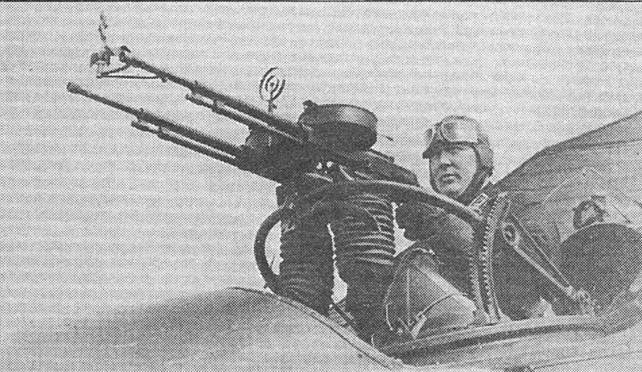
Guns' Arms Trust, in charge of which, among others, was the Kovrov Plant, August 17 1928. reported to the Red Army Artillery Directorate about the readiness of a tank machine gun based on the Degtyarev machine gun. 12 June 1929 of the year, after carrying out the appropriate tests, the tank machine gun DT (“Degtyarev, tank”, also called the “tank machine gun of the model 1929 of the year”) in a spherical installation, developed by G.S. Shpigin The adoption of this machine gun coincided with the deployment of mass production of tanks - Degtyarev tank replaced the paired 6,5-millimeter tank machine gun Fedorov already put on armored vehicles, began to install on the T-24, MS-1 tanks, BA-27 armored vehicles, all armored vehicles, all armored vehicles, BA-XNUMX, and all armored vehicles.
The tank machine gun Degtyarev was missing the barrel cover. The barrel itself was notable for additional ribs. DP was equipped with a retractable metal butt having a folding shoulder support, a pistol grip control, a compact double-row disc magazine on the 63 cartridge, a sleeve. The fuse and pistol grip were the same as the YES. Flap fuse, placed on the right above the trigger guard, was made in the form of checks with a beveled axis. The back position of the flag corresponded to the state of "fire", the front one - "fuse". Sight - diopter rack. The diopter was mounted on a special vertical engine and, using spring-loaded latches, was installed in several fixed positions that corresponded to the 400, 600, 800 and 1000 distance ranges. The sight was equipped with an adjusting screw for zeroing. The front sight on the machine gun was not installed - it was fixed in the front disc of the ball mount. In some cases, the machine gun was removed from the installation and used outside the car, so the bracket with a front sight and removable bipod attached to the faceplate were attached to the diesel engine. The weight of the machine gun with the magazine was 10,25 kilogram, length - 1138 millimeters, combat rate of fire - 100 shots per minute.
The Degtyarev tank machine gun was used as a coaxial machine gun with a large-caliber machine gun or tank gun, as well as on a special anti-aircraft tank unit. Degtyarev tank during the Second World War was often used as a manual - the combat rate of fire of this machine gun was twice as high as that of the infantry model.
It should be noted that already at the beginning of the Great Patriotic War, the option of replacing diesel fuel with a “tank” submachine gun with a large ammunition was developed (developed on the basis of PCA). After the end of the Second World War, the Finns made an attempt to do the same on the captured tanks using their own “Suomi”. However, in both cases, DT vehicles remained on armored vehicles and tanks. On the Soviet tanks, only SGMT could replace the tank machine gun Degtyarev. An interesting fact is that after the forced “decorative” rework of armored vehicles and tanks in the Military History Museum of armored weapons and equipment in Kubinka Degtyarev, the tank proved to be an “international” machine gun — the “native” machine guns are imitated on a large number of foreign vehicles with DT barrels.
Note that in 31, 34 and 38 of the vulgar century, Degtyarev presented modernized versions of DP. In 1936, he proposed a lightweight airborne version without a casing, with reinforced fins and locking with a single lug, in addition the machine gun was completed with a compact box-shaped magazine having a sector shape. Then the designer presented a machine gun, having the same store, with the transfer of a reciprocating combat spring into the butt. Both machine guns remained experienced. On the DP, a sight was installed on an experimental basis with the possibility of introducing lateral corrections, the PD equipped with a telescopic sight was tested in the 1935 year - the idea of supplying light machine guns with a telescopic sight was popular for a long time, even though the practice was unsuccessful.
After the fighting on the island of Hassan in 1938, the commanders received a proposal to adopt a light machine gun having a power system of the Japanese type “11” machine gun - with the equipment of a permanent magazine with rifle cartridges. This proposal was actively supported by G.I. Kulik, head of GAU. Kovrovtsy represented the version of the Degtyarev light machine gun with the receiver Razorenova and Kupinov under the clips from the 1891 / 1930 model rifle, but very soon the question of such a receiver was rightly removed - the practice forced to abandon the clip-on or pack power of the light machine guns, leaving the military experts and gunsmiths before Choosing "tape or store."
For a long time Degtyarev worked on the creation of a universal (single) and easel machine gun. In June-August 28, Artcom on the instructions of the Red Army Headquarters, developed tactical and technical requirements for the new machine gun - the basis of the machine gun, for the purpose of unification, was to take the infantry machine gun Degtyarev under the same cartridge, but having tape feed. Already in 30, the designer introduced an experienced machine gun with a universal machine Kolesnikov, a tape power receiver (Shpagin system) and a reinforced barrel radiator. Finishing of the machine gun of Degtyarev (“Degtyarev, easel”, DS) dragged on until the end of 1930's and did not give positive results. In 1936, Degtyarev presented a universal modification of the DP, which has a lightweight folding, integral tripod machine and a mount for a folding anti-aircraft ring sight. This sample also has not progressed further experienced. The weakness of the regular bipods caused limited use with the Degtyarev infantry machine gun installation with additional rods, which with bipods form a triangular design. The system of locking the barrel and automatics, embodied in the Degtyarev machine gun, was also used in a large-caliber machine gun and an experienced automatic rifle developed by Degtyarev. Even the first Degtyarev submachine gun, developed in 1929, which has a semi-free bolt, carried the constructive features of the DP machine gun. The designer sought to implement the idea of Fedorov, his teacher, about a unified family of weapons based on his own system.
At the beginning of the Second World War, in the Detyaryevsky KB-2 Kovrovsky plant, in an experimental manner, created the so-called “heavy fire installation” - the fourth DP (DT) installation for arming infantry, cavalry, armored vehicles, light tanks, as well as anti-aircraft defense needs. Machine guns were installed in two rows or in the horizontal plane and supplied with regular disk magazines or box-shaped for 20 cartridges. In the "anti-aircraft" and "infantry" variants, the installation was mounted on a universal Kolesnikov machine tool designed for large-caliber DShK. The rate of fire - 2000 shots per minute. However, this way of “fighting for the rate of fire” did not justify itself, and the effect of return on installation and dispersion was too great.
DP machine gun service
The machine gun of Degtyarev became the most massive machine gun of the Armed Forces of the USSR for two decades - and these years were the most “military”. The DP machine gun passed its baptism of fire during the conflict on the CER in the border units of the OGPU - therefore, in April 1929, the Kovrov plant received an additional order for the release of these machine guns. A DP machine gun as part of the forces of the United State Political Directorate fought in Central Asia against the Basmachis. The DP was later used by the Red Army in hostilities on Hasan Island and on the Khalkhin Gol River. Together with other Soviet weapons, he "took part" in the Spanish Civil War (here, the DP had to "fight side by side" with its long-time rival MG13 "Draze"), in the war in China, in the 39-40 he fought on the Karelian Isthmus. The DT and YA-2 modifications (on the P-5 and TB-3 aircraft) went through the same way, so that we can say that by the beginning of the Second World War, Degtyarev's machine gun had been tested in various conditions.
In rifle subunits, the infantry machine gun Degtyarev was introduced into the rifle platoon and the squad, in cavalry - in the saber division. In both cases, the light machine gun, along with the rifle grenade launcher, was the main weapon of support. The DP, with a notch of sight to 1,5 thousand meters, was intended to destroy important single and open group targets at ranges up to 1,2 thousand meters, small living single targets - to 800 meters, to defeat low-flying aircraft - to 500 meters, and also to support tanks by firing TCP calculations. The shelling of the inspection slots of armored vehicles and enemy tanks was conducted from 100-200 meters. The fire was fired in short bursts of 2-3 shots or bursts of 6 shots; continuous continuous fire was allowed only in extreme cases. Heavy machine gunners with a lot of experience could have aimed fire with single shots. The calculation of the machine gun - 2 man - machine gunner ("gunner") and assistant ("second number"). The assistant carried the stores in a special box designed for three discs. In order to bring ammunition to the calculation gave two more fighters. For transportation DP in cavalry used saddle bag VD.
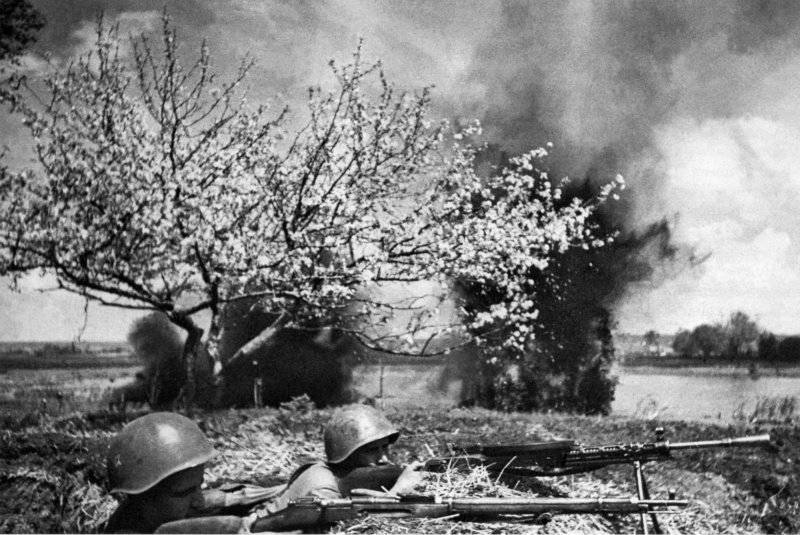
To hit air targets could be used anti-aircraft tripod sample 1928, developed for the machine gun "Maxim". Also developed a special motorcycle installation: motorcycle M-72 had a simple swivel frame, pivotally mounted on a wheelchair, boxes with spare parts and disks were placed between the sidecar and motorcycle and on the trunk. Attaching a machine gun allowed keeping anti-aircraft fire from the knee without removing it. On a motorcycle TIZ-AM-600 DT was mounted above the steering wheel on a special bracket. To reduce the cost of training and the use of small shooting ranges on the Degtyarev machine gun, a 5,6-millimeter training Blum machine gun could be mounted, which used a ring ignition cartridge and the original disc magazine.
The DP machine gun quickly gained popularity, as it successfully combined the power of fire and maneuverability. However, along with the merits of the machine gun had some drawbacks that manifested during operation. First of all, it concerned the inconvenience of operation and features of the equipment of the disk store. The quick replacement of the heated trunk was complicated by the lack of handles on it, as well as the need to separate the nozzle and the bipod. Replacing, even under favorable conditions, a trained calculation took about 30 seconds. An open gas chamber located under the barrel prevented the accumulation of carbon in the gas discharge unit, but together with the open barrier frame it increased the likelihood of clogging on sandy soils. The clogging of the socket of the gas piston and the screwing of its head caused the non-revenue of the moving part to the forward extreme position. However, the automatic machine gun as a whole has demonstrated a fairly high reliability. Attachment of swivels and bipods was unreliable and created additional catching details that reduced the ease of carrying. Work with the gas regulator was also inconvenient - for its rearrangement the pin was taken out, the nut was unscrewed, the regulator was set back, turned and fixed again. It was possible to fire when moving only using a belt, and the absence of a forearm and oversize store made such shooting inconvenient. The machine-gunner put a belt in the form of a loop around his neck, fastened it in front of the store to the cut-out of the casing with antab, and to keep the machine gun behind the casing, a mitten was needed.
In the armament of rifle divisions, the share of machine guns was constantly increasing primarily due to light machine guns - if in the 1925 year the rifle division per 15,3 thousand people. personnel had 74 machine guns, then already in 1929, on 12,8 thousand people. there were 81 light and 189 heavy machine guns. In the 1935, these figures on the 13 thous. People already comprised the 354 light and 180 heavy machine guns. In the Red Army, as in some other armies, the light machine gun was the main means of saturating the troops with automatic weapons. The state of April 1941 of the year (the last pre-war one) provided for the following relationships:
rifle division of wartime - on 14483 people. personnel had 174 machine guns and 392 light machine guns;
reduced division - on 5864 people. personnel had 163 machine guns and 324 light machine guns;
Mountain Division - on 8829 people. The personnel had 110 machine guns and 314 light machine guns.
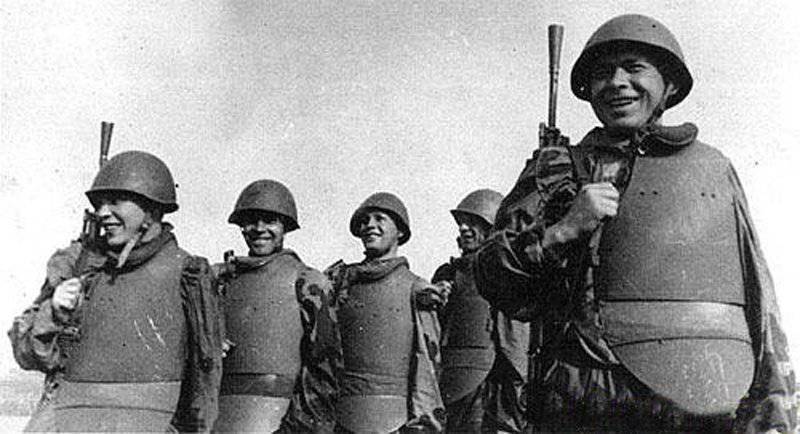
DP was in service in the cavalry, marines, troops of the NKVD. The Second World War, which began in Europe, a clear percentage increase in the German Wehrmacht, the number of automatic weapons, the ongoing reorganization of the Red Army demanded an increase in the production of tank and light machine guns, as well as changes in the organization of production. In the year 1940 began to increase production capacity used in the production of light machine guns. By this time, the manufacturing technology of barrel trunking had been worked out, which made it possible to accelerate several times and significantly reduce the cost of barrel production - together with the transition to the use of barrels with a cylindrical smooth outer surface, played an important role in increasing output and reducing the cost of Degtyarev infantry machine guns. The order for 1941 year, approved by 7 February, included 39 thousand infantry and tank machine guns Degtyarev. At the Kovrov Plant No. 2, with 17 on April 1941, the OGK produced DT and DP machine guns. Since April 30, the production of DP machine guns has been deployed in the new "L" building. The People's Commissariat of Arms gave the new production the rights of a branch of the enterprise (later - a separate Kovrovsky Mechanical Plant).
From 1939 to mid-1941 in the army, the number of light machine guns increased by 44%, on 22 June 41, the Red Army had 170,4 thousand light machine guns. This type of armament was one of those with whom the connections of the western districts were provided even in excess of the state. For example, in the Fifth Army of the Kiev Special Military District, the manning of light machine guns was about 114,5%. During this period, Degtyarev tank machine guns were interesting - by the Directive of the General Staff from 16 in May 1941, 50 of the newly formed mechanized corps tank regiments to manning tanks to fight enemy armored vehicles and guns for 80 DT for the regiment for self-defense. During the war, Degtyarev tank was also put on combat snowmobiles.
With the beginning of the Second World War, the outdated DA-2 found a new use - as anti-aircraft machine guns for dealing with aircraft flying at low altitude. 16 July 1941, Osipov, Head of the Main Directorate of Air Defense, wrote to Yakovlev, Head of the SAU: “The non-set of anti-aircraft machine guns can be eliminated to a large extent by adapting anti-aircraft fire to 1,5 for thousands of paired DA-2 machine guns and as many shot from aircraft planes PW-1 ". For this, the YA and YA-2 machine guns were installed on the anti-aircraft tripod of the 1928 model of the year through the kingpin - in particular, such installations were used near Leningrad in 1941 year. The fly vane was replaced with a ring from a machine gun anti-aircraft sight. In addition, YES-2 was installed on a light night bomber Y-2 (Po-2).
During the Great Patriotic War, the main manufacturer of machine guns for infantry and tank machine guns of Degtyarev was the workshop No.1 of plant No.2, their production was also delivered in the Urals, DP and at the Arsenal plant (Leningrad). Under the conditions of military production, the requirements for finishing small arms had to be reduced — for example, finishing machining of exterior parts and parts not involved in the work of automation was abolished. In addition, the rules for spare parts and tools were reduced - instead of 22 disks, only 12 was given to each machine gun laid before the start of the war. Despite this, all technological documentation was carried out “by letter B”, that is, it required strict compliance with all standards and did not allow changes in the shape, materials of parts and sizes at all plants involved in production. Production of light machine guns, despite the difficult conditions, remained relatively stable. V.N. Novikov, Deputy Commissar of Weapons, wrote in his memoirs: “This machine gun did not cause any particular strain on the Armed Forces Commissariat.” For the second half of 41, troops received 45300 light machine guns, 42 172800, 43 250200, 44 179700. In the army on the 9 in May 1945, there were 390 thousand light machine guns. Throughout the war, the loss of light machine guns amounted to 427,5 thousand units, that is, 51,3% of the total resource (taking into account the pre-war stocks and pre-war stocks).
The scale of the use of machine guns can be judged by the following figures. GAU from July to November 1942 transferred 5 302 machine guns of all types to the fronts of the south-west direction. In March-July, in preparing for the Battle of Kursk, the troops of the Steppe, Voronezh, Central Fronts and the Eleventh Army received 1943 thousand light and heavy machine guns. The troops that launched an offensive near Kursk had 31,6 thousand machine guns of all types. In April 60,7 of the year, to the beginning of the Crimean operation, the troops of the Separate Maritime Army, the Fourth Ukrainian Front and air defense units had 1944 heavy machine guns and light machine guns (approximately 10622 machine gun per 1 of a man of personnel). In the armament of the infantry also changed the proportion of machine guns. If the rifle company in July 43 had the 1941 light machine guns all over the world, a year later 6 light machine guns, in the 12 year 1943 heavy machine guns and 1 light machine guns, and in December 18 year - 44 heavy machine guns and 2 light machine guns. That is, during the war, the number of machine guns in the rifle company, the main tactical division, more than doubled. If in July 12 there were 41 machine guns of various types in service with the rifle division, then in December of the same year 270, in a year this figure was already 359, and in June 605 of the year 45. The decrease in the share of machine guns by the end of the war is due to an increase in the number of submachine guns. Applications for light machine guns were reduced, so from 561 January to 1 in May 10, only 1945 was handed over (in addition, at that time, upgraded DPs were supplied). By the end of the war, the rifle regiment had 14500 light and 108 heavy machine guns on 54 2 people.
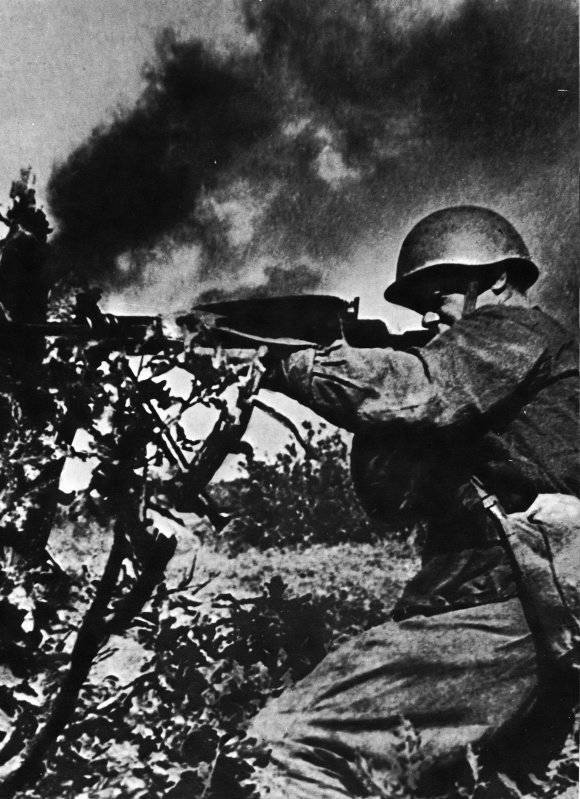
During the war, revised the rules for the use of a machine gun, although with respect to tame it was required to a lesser extent. By the “Infantry Combat Regulations” of 1942, the range of opening the fire from a light machine gun was set from a range of 800 meters, but also recommended a sudden fire from a range from 600 meters as the most effective. In addition, they canceled the division of the battle order into “constraining” and “shock” groups. Now a light machine gun in various conditions acted in a chain of platoon and squad. Now the main for him was considered fire in short bursts, the combat rate of fire was equal to 80 shots per minute.
In winter conditions, the ski units carried the Maxim and DP machine guns on dragging boats in a state of readiness for opening fire. To drop the machine guns to the partisans and paratroopers, the parachute parachute sack of PMMM-42 was used. At the beginning of the war, the paratroopers-machine-gunners had already mastered jumping with regular infantry machine-guns of Degtyarev on a belt, instead they often used the “manual” version of a more compact tank machine-gun, with a larger-capacity magazine that was less prone to death. In general, the gun Degtyarev proved to be a very reliable weapon. This was recognized by opponents - for example, captured DPs were readily used by Finnish machine-gunners.
However, the experience of the use of an infantry machine gun Degtyarev pointed to the need for a lighter and more compact sample with preservation of ballistic characteristics. In 1942, a competition was announced for the development of a new system of a light machine gun, the weight of which does not exceed 7,5 a kilogram. From 6 to 21 in July, 1942 was tested by experienced machine guns developed by the Degtyarev Design Bureau (with magazine and tape feed), as well as the designs of Vladimirova, Simonov, Goryunov, and novice designers, including Kalashnikov, underwent ground tests. All samples submitted for these tests received a list of comments on refinement, but as a result the competition did not produce an acceptable sample.
DPM light machine gun
Work on the modernization of the Degtyarev infantry machine gun was more successful, especially since the production of the upgraded version can be carried out much faster. At this time at the plant number XXUMX worked several design teams solving their range of tasks. And if KB-2, under the leadership of V.A. Degtyareva, mainly working on new designs, then the task of upgrading the produced models were solved in the Department of the chief designer. Works on the modernization of machine guns led by A.I. Shilin, however, Degtyarev himself did not let them out of his sight. Under his control, a group of designers, which included P.P. Polyakov, A.A. Dubynin, A.I. Skvortsov A.G. Belyaev, conducted in the 2 year work on the modernization of the DP. The main purpose of these works was to increase the manageability and reliability of the machine gun. N.D. Yakovlev, Head of the State Agrarian University, and D.F. Ustinov, Commissar of Arms, in August 1944, submitted for approval by the State. The Defense Committee changes in the design, indicating at the same time: "In connection with the constructive changes in the upgraded machine guns:
- the durability of the recoil-fighting spring increased, it became possible to replace without removing the machine gun from the firing position;
- the possibility of loss of bipods is excluded;
- accuracy and accuracy of fire improves;
- Improves usability in combat conditions. "
The GKO decision of 14 in October 1944, the changes were approved. The machine gun was adopted under the designation PDM ("Degtyarev, infantry, modernized").
Differences machine gun PDM:
- a return spring from under the barrel, where it was heated and given draft, was transferred to the back of the receiver (the spring was tried to be transferred even 1931 to the year, this can be seen from the Degtyarev experimental machine gun presented at that time). To install the spring on the tail of the striker, a tubular rod was put on, and a guide tube was inserted into the butt plate, which protruded above the neck of the butt. In this regard, the coupling was excluded, and the rod was made in the form of a single part with a piston. In addition, the order of disassembly has changed - now it started with a guide tube and a returnable combat spring. The same changes were made to the tank machine gun Degtyarev (DTM). This made it possible to disassemble the machine gun and fix minor faults without removing it from the ball mount;
- installed a pistol grip control in the form of a slope, which was welded to the trigger guard, and two wooden cheeks, fastened to it with screws;
- simplified the shape of the butt;
- on a light machine gun, instead of an automatic safety device, a non-automatic flag safety device was introduced in the manner of a Degtyarev tank machine gun - the beveled axis of the fuse checks was under the trigger lever. Locking occurred at the front position of the flag. This fuse was more reliable, since it acted on the sear, which made it safer to carry a loaded machine gun;
- the leaf spring in the ejection mechanism has been replaced by a helical cylindrical one. The ejector was installed in the nest of the bolt, and a pin was used to hold it, which also served as its axis;
- folding bipods were made integral, and fastener hinges moved a little back and higher relative to the axis of the bore. On the upper part of the casing, they installed a collar of two welded plates, which formed the eyes, for fastening the legs of the bipods with screws. Bipods have become stronger. To replace their trunk is not required to separate;
- The weight of the machine gun has decreased.
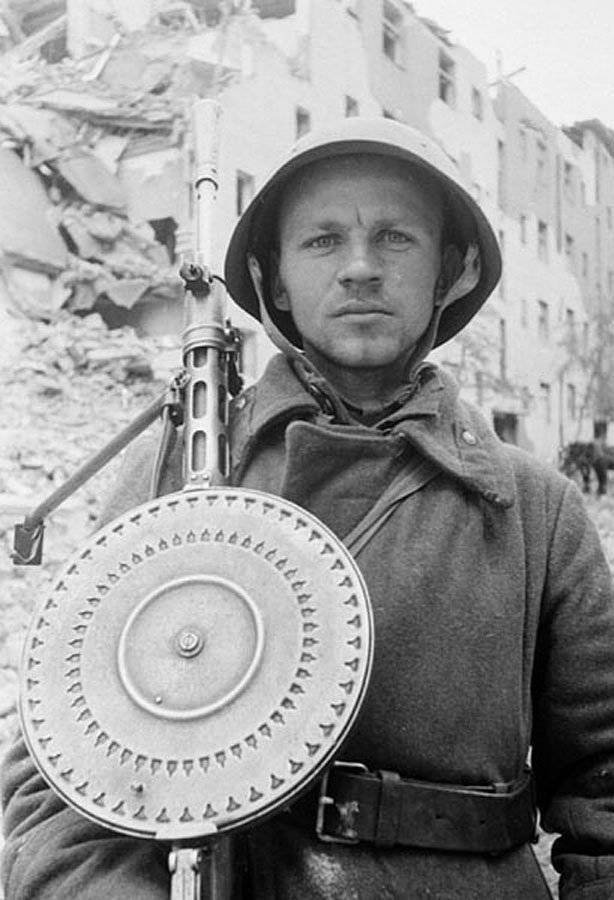
The modernized tank machine gun of Degtyarev was adopted at the same time - October 141944, the release of DT stopped 1 January 1945 year. Part of lightly loaded parts, such as, a retractable butt of a DT machine gun, to reduce prices, were made by cold stamping. During the works, a variant of the PDM with a retractable butt was proposed as in DT, however, they stopped on a wooden butt, as more reliable and convenient. In addition, it was proposed to supply the modernized tank gun of Degtyarev with a weighted barrel with longitudinal lobes (as in the experimental DS-42), but this option was also refused. In total, in the period from 1941 to 1945, at the Kovrov plant No.2, 809 823 machine guns of the DP, DT, DPM and DTM machine guns were launched.
In addition to the Soviet Union, the DP (DPM) machine guns were in service with the armies of the GDR, PRC, Vietnam, Cuba, North Korea, Poland, Mongolia, Somalia, Seychelles. The machine gun PDM in China was released under the designation "Type 53", this option was used in Vietnam, was in service with the army of Albania.
"Degtyarev infantry" in service with the Soviet Army replaced the new manual machine gun Degtyarev RPD under the intermediate 7,62-mm cartridge model 1943 of the year. Stocks of PD and PDM remaining in warehouses "surfaced" in 80-xNNX-s during post-perestroika military conflicts. These machine guns fought in Yugoslavia.
Rotary machine gun model 1946 year (RP-46)
The large dead weight and bulkiness of the disk shop of the Degtyarev machine gun caused repeated attempts to replace it with a tape power supply both before the start of the Second World War and during it. In addition, ribbon power made it possible in a short period of time to increase the power of fire and thereby fill the gap between the capabilities of the easel and light machine guns. The war revealed a desire to increase the density of anti-personnel fire in the most important areas - if in 42, in defense, the density of gun and machine-gun fire per running meter of the front ranged from 3 to 5 bullets, then in the summer of 1943, during the Kursk battle, this figure was already 13-14 bullets .
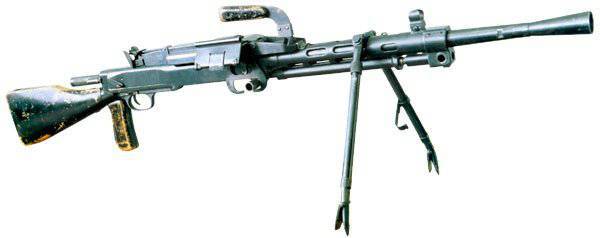
In total, for the machine gun of the Degtyarev infantry machine guns (including the upgraded one) 7 variants of the receiver for the tape were developed. Locksmiths debuggers PP Polyakov and A.A. Dubinin in 1942 to the DP manual machine gun developed the next version of the receiver for a metal or canvas tape. In June of the same year, machine guns with this receiver (parts were stamped) were tested at the GAU test site, but they were returned for revision. Two variants of the receiver for the tape in 1943 were presented by Degtyarev (in one of the variants the drum receiver of the Shpagin circuit was used). But the heavy weight of the machine gun, the kilogram that reached 11, the inconvenience of using the power supply system, as well as the workload of the Kovrov plant No. XXUMX with more urgent orders caused a break in this work.
However, the work in this direction did not stop completely. The successful development of tape feed in the RPD machine gun was the basis for resuming work on the introduction of similar feed for PDM for rifle cartridges. In May, the standard PD and the not yet adopted modernized PDM, equipped with the PP design receiver, were tested by 1944. Polyakova and A.A. Dubinin - the regular participants in the modernization of the "Degtyarev Infantry" - under the leadership of designer Shilin, with the participation of locksmith-debugger Lobanov. As a result, this option was adopted receiver.
The feed mechanism of the link metal strip was driven by the movement of the bolt carrier during its movement - a similar principle was used in the 12,7-mm machine gun of the ASC, but now the movement of the handle to the receiver was transmitted through a special sliding bracket, and not through a swinging arm. Tape - link metal, with a closed link. The feed is on the right. Special tray served to guide the tape. The latch of the receiver cover was placed similarly to the latch of stores on PD (PDM). Barrel weighted for the possibility of firing long lines. The new barrel, the need to drive the feed tape and efforts to feed the cartridges from the tape required to make changes in the design of the vapor compartment. The design, controls and layout of the machine gun were otherwise the same as the base PDM. The rate of fire reached 250 shots per minute, which was three times higher than the speed of the PDM and was comparable to machine guns. In terms of the effectiveness of fire at ranges up to 1000 meters, it approached a single and heavy machine gun, although the absence of a machine did not give the same controllability and accuracy.
24 May 1946, the machine gun thus upgraded was adopted by a decree of the Council of Ministers of the USSR under the designation "7,62-mm company gun of the 1946 model of the year (RP-46)". RP-46 was the last offspring of the unified "DP family" (RPD, although it was a development of the same scheme, became a fundamentally new weapon). The name "company machine gun" indicates the desire to fill the niche of automatic weapons to support the company level - heavy machine guns were the means of the battalion commander, manual - were in platoons and squads. According to their characteristics, machine guns did not correspond to the increased mobility of infantry, could act only on the flanks or in the second line, rarely provided timely and sufficient support to the advanced lines of infantry in the conditions of increased transience and maneuverability of combat — especially on rough terrain, settlements and mountains. At the same time, the light machine gun of the same caliber did not develop the fire of the necessary power. In fact, the talk was about the temporary replacement of the “single” machine gun, which was not yet available in the weapon system, or about the next step towards the creation of a domestic single machine gun. The RP-46 machine gun, which was 3 times lighter than the SGM, was significantly superior to this regular machine gun in terms of maneuverability. In addition, RP-46 was included in the armament of light armored vehicles (airborne assault systems-57) as an auxiliary weapon of self-defense.
The combination of a waste system in production and a receiver assembled from cold stamping parts made it possible to quickly launch the production of a new machine gun. Tape power reduced the weight of the ammunition carried by calculation - if RP-46 without cartridges weighed more than the DP on 2,5 kg, then the total weight of RP-46 with the ammunition on 500 cartridges was on 10 kilograms less than that of the PD having the same stock of cartridges. The machine gun was equipped with a folding shoulder support and a carrying handle. But a separate cartridge box caused difficulties in combat, since changing the position of the RP-46 in most cases required removing the tape and charging it in a new position.
RP-46 for 15 years was in service. His machine gun and SGM replaced a single PC machine gun. In addition to the USSR, RP-46 was in service in Algeria, Albania, Angola, Bulgaria, Benin, Kampuchea, Congo, China, Cuba, Libya, Nigeria, Togo, Tanzania. In China, a copy of RP-46 was released under the designation “Type 58”, and in the DPRK - “Type 64”. Although in terms of output RP-46 was significantly inferior to its “parent”, it is still found in some countries today.
Specifications machine gun RP-46:
Cartridge - 7,62-mm sample 1908 / 30's (7,62x53);
Weight - 13 kg (with curb tape);
The length of the machine gun with a flame arrester - mm 1272;
Barrel length - 605 mm;
The length of the threaded part of the trunk - 550 mm;
The grooves - 4 rectangular, right;
The length of the stroke rifling - 240 mm;
Initial bullet speed (heavy) - 825 m / s;
Sighting range - 1500 m;
Direct shot range - 500 m;
The range of slaughter bullet - 3800 m;
Sighting line length - 615 mm;
The rate of fire - 600 shots per minute;
Combat rate - up to 250 shots per minute;
Food - metal tape on 200 / 250 cartridges;
Weight curb tape - 8,33 / 9,63 kg;
Calculation - 2 person.
BIBLIOGRAPHY
1. Bakhirev V.V., Kirillov I. I. Designer V. A. Degtyarev. M., “Voenizdat”, 1979.
2. Battle Regulations infantry of the Red Army, hh. 1,2. M., “Voenizdat”, 1945-46.
3. Bolotin D.N. History Soviet small arms and ammunition. SPb., "Polygon", 1995.
4. Bolotin D. N. Soviet small arms for 50let. Leningrad, VIMAIVVS Edition, 1967.
5. Vladimirsky A.V. On Kiev direction. M., “Voenizdat”, 1989.
6. Pack transport of the Red Army. Brief description and exploitation. M., 1944.
7. The vulture is removed. M., “Voenizdat”, 1993.
8. Degtyarev V.A. My life. Tula, Regional Book Publishing House, 1952.
9. Egorov P. Combat use of ski units // Military Herald 1943 №23-24.
10. Plant them. V.A. Degtyareva, Strokes of history. Carpet, 1999.
11 Klementyev V. On the armament of the mountain infantry // Military Gazette 1946 №17-18.
12. Malimon AA Domestic machines (notes of the gunsmith tester). M., Ministry of Defense of the Russian Federation, 1999.
13. The material part of small arms. Edited by A.A. Blagonravov. Book 2. M., “Gosvoyenizdat”, 1946.
14. Monetchikov S. They did victory / / Weapons 2000 №6.
15. Manual on the shooting case. Weapon rifle platoon. M., Department of Publishing NPO USSR, 1935.
16. Manual on the shooting case. Basics of shooting from infantry weapons. M., “Voenizdat”, 1946.
17. Novikov V.N. On the eve and in the days of testing. L /., "Politizdat", 1988.
18. The bases of the device of small arms. Edited by V.N. Zaitsev. M., “Voenizdat”, 1953.
19. N. Okhotnikov. Small arms of the Soviet Army in the Great Patriotic War // Military History Magazine 1969 No. XXUMX.
20. Portnov ME, Slostin V.I. Chronicle of the development of domestic weapons. Release the first. Weapon. M., "Army Collection", 1995.
21. Fedorov V.G. The evolution of string weapons, t.2. L /., "Voenizdat", 1939.
22. Horkov A.G. Thunderstorm June. M., “Voenizdat”, 1991.
23. Yakovlev N.D. About artillery and a little about yourself. L /., "High School", 1984.
24. Yanchuk AM Reference ballistic and design data of small arms. M., Edition of the Artillery Academy of the Red Army, 1935.
25. Hogg, /., Weeks J. Military Small Arms of the 20-th Century. Northbrook, DBI Books, 1996.
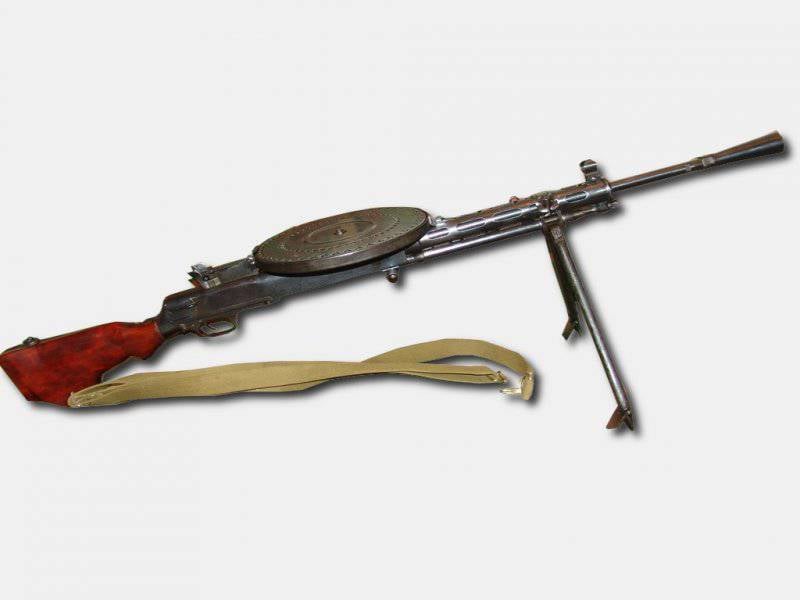
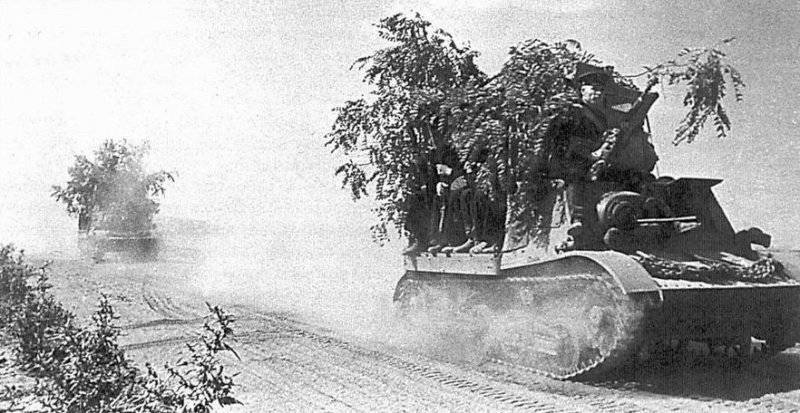
Information